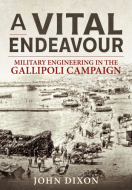
- Agriculture
- Architecture & Design
- Arts & Photography
- Biography
- Business
- Calendars and Diaries
- Childrens (All)
- Childrens (Illustrated)
- Childrens (Picture flats)
- Childrens (Te Reo)
- Classics
- Cooking, Food & Drink
- Craft & Hobbies
- Design (Art / Graphics)
- Design (Interiors)
- Education
- Fashion
- Fiction & Literature
- Fiction - Young Adult
- Gift Ideas
- Health & Wellbeing
- History
- Home & Garden
- Humour & Gift
- Instead of a Card Poems
- Military
- Music
- New Zealand
- NZ (History)
- NZ (Landscapes)
- NZ (Pictorial)
- Poetry
- Reference
- Religion & Faith
- Science & Nature
- Sport & Recreation
- Stationery
- Taschen : 40th Anniversary Edition
- Taschen : BA Basic Art
- Taschen : BU Bibliotheca Universalis
- Te Reo Māori
- Transport
- Travel
John Dixon (2)
|
A Vital Endeavour
ISBN: 9781911628897 Author: John Dixon Publisher: Helion & Company Whilst the Gallipoli Campaign has received considerable interest over the years, the work of the Royal Engineers during that campaign has been largely overlooke... Whilst the Gallipoli Campaign has received considerable interest over the years, the work of the Royal Engineers during that campaign has been largely overlooked. This book seeks to address this oversight to demonstrate the amount of engineering work required for a seaborne invasion. It was the engineers that provided the technical and professional back up for the rest of the Mediterranean Expeditionary Force and produced the know-how to keep the men in the front line supplied with all manner of necessities for their work. The Royal Engineers were working on the first day of the landings and were amongst the last to leave on the evacuation, and their story includes all the major engagement of the campaign. It also includes the sometimes difficult tasks of providing infrastructure to the peninsula handling all kinds of engineering works, from piers to land the stores, to roads and railways to distribute the equipment to the various parts of the line. A large part of their work on Gallipoli was the location and development of water supply across this dry peninsula. They dug wells, constructed reservoirs and provided miles of piping to connect both with watering points across the dry landscape. They were also responsible for all the land based signaling, with a number of signal companies established to ensure that messages were relayed with as little delay as possible. It was not long after the first exchanges that it was clear that some of the siege techniques of the Western Front would need to be employed and the Royal Engineers provided the expertise for the mining work that took the underground war to the Turkish army. It was not long thereafter that the Allied miners had a more or less complete mastery of the underground war. The demands of the front line fighting man meant that the Royal Engineers needed to rapidly become masters of their environment as they carried on their construction work throughout the campaign, and were ultimately to carry a large responsibility for providing the means to evacuate the soldiers and stores when an end to the campaign was called. The book looks at the structure of the Royal Engineers at the beginning of the Great War and the way in which in which they sat within the structure of the MEF and how their work was controlled at Brigade, Division and Corps level. This book is organized to show the work of the Royal Engineers, and the units of the Australian and New Zealand armies, at each stage of the campaign, putting their work in the context of the major offensives of the campaign. It also addresses briefly the work of the engineers on the nearby islands, such as Imbros, where GHQ was based, and Lemnos where engineers worked on everything from harbours to hospitals. Bind: paperback Pages: 452 Dimensions: 170 x 245 mm |
$90.00 |
|
|
The Fight For Life
ISBN: 9781804513255 Author: John Dixon Publisher: Helion & Company The Fight for Life: The Medical Services in the Gallipoli Campaign 1915–16 examines the development of the medical services immediately prior to the First Wor... The Fight for Life: The Medical Services in the Gallipoli Campaign 1915–16 examines the development of the medical services immediately prior to the First World War and its involvement in the failed Gallipoli Campaign. Although crucial to the entire operation, the planning for their involvement was both late and insufficient. In consequence, the services received considerable criticism both during and after the campaign. The Fight for Life explores the actual steps taken in the planning and the work carried out by the medical services at each stage of the campaign. Casualties sustained at the start of the Gallipoli operations were mainly combat-related but, as operations developed, there were a large number of sick caused by diseases such as dysentery and enteric fever. Much of this was related to poor sanitation, absence of water and the ever-present plague of flies. The causes of the diseases are examined and considered in light of the overall lack of success of the initial landings which prevented the routine development of sanitation, rest camps and base hospitals. The development of base hospitals is considered in respect to the increasing casualties arriving from the battlefield and the development of institutions in Egypt and later in Malta is considered in some detail. Early planning for such hospitals underestimated casualty figures and this was also a direct result of the lack of success during the first phase of the campaign. Further to this, the employment of hospital ships is explored together with the oft- criticised use of transports or ‘Black Ships’ for the same purpose. These vessels were a vital link in the treatment of the wounded and sick of the peninsula and in many cases they were forced to act as floating casualty clearing stations as their staff treated thousands, moving some to hospitals at both Lemnos and Imbros before sailing to base hospitals in Alexandria, Cairo or indeed Malta. The importance of nursing care aboard these ships is also considered, as nurses struggled to cope under adverse conditions. The harrowing winter 1915–16 storms are considered from the medical standpoint which added stress to a system working to cope with day-to-day casualties. The role played by the medical services in the evacuation of the peninsula is considered and the organization required for removal of casualties during the preparations cannot be overstated. Finally, a short analysis of the findings of the Dardanelles Commission as it applies to the medical services is provided. Bind: paperback Pages: 342 Dimensions: 170 x 245 mm Publication Date: 24-01-2024 |
$79.99DUE > 30th Jun 2024 |





